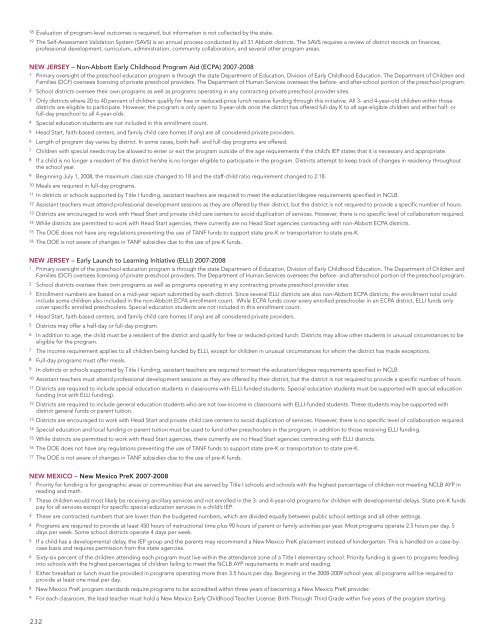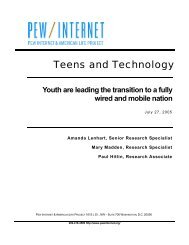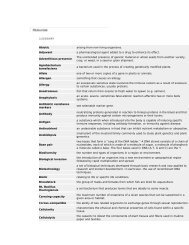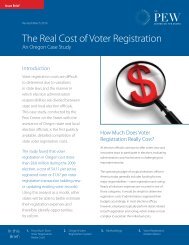Report: The State of Preschool 2008: State Preschool Yearbook
Report: The State of Preschool 2008: State Preschool Yearbook
Report: The State of Preschool 2008: State Preschool Yearbook
Create successful ePaper yourself
Turn your PDF publications into a flip-book with our unique Google optimized e-Paper software.
18 Evaluation <strong>of</strong> program-level outcomes is required, but information is not collected by the state.<br />
19 <strong>The</strong> Self-Assessment Validation System (SAVS) is an annual process conducted by all 31 Abbott districts. <strong>The</strong> SAVS requires a review <strong>of</strong> district records on finances,<br />
pr<strong>of</strong>essional development, curriculum, administration, community collaboration, and several other program areas.<br />
NEW JERSEY – Non-Abbott Early Childhood Program Aid (ECPA) 2007-<strong>2008</strong><br />
1 Primary oversight <strong>of</strong> the preschool education program is through the state Department <strong>of</strong> Education, Division <strong>of</strong> Early Childhood Education. <strong>The</strong> Department <strong>of</strong> Children and<br />
Families (DCF) oversees licensing <strong>of</strong> private preschool providers. <strong>The</strong> Department <strong>of</strong> Human Services oversees the before- and after-school portion <strong>of</strong> the preschool program.<br />
2 School districts oversee their own programs as well as programs operating in any contracting private preschool provider sites.<br />
3 Only districts where 20 to 40 percent <strong>of</strong> children qualify for free or reduced-price lunch receive funding through this initiative. All 3- and 4-year-old children within those<br />
districts are eligible to participate. However, the program is only open to 3-year-olds once the district has <strong>of</strong>fered full-day K to all age-eligible children and either half- or<br />
full-day preschool to all 4-year-olds.<br />
4 Special education students are not included in this enrollment count.<br />
5 Head Start, faith-based centers, and family child care homes (if any) are all considered private providers.<br />
6 Length <strong>of</strong> program day varies by district. In some cases, both half- and full-day programs are <strong>of</strong>fered.<br />
7 Children with special needs may be allowed to enter or exit the program outside <strong>of</strong> the age requirements if the child’s IEP states that it is necessary and appropriate.<br />
8 If a child is no longer a resident <strong>of</strong> the district he/she is no longer eligible to participate in the program. Districts attempt to keep track <strong>of</strong> changes in residency throughout<br />
the school year.<br />
9 Beginning July 1, <strong>2008</strong>, the maximum class size changed to 18 and the staff-child ratio requirement changed to 2:18.<br />
10 Meals are required in full-day programs.<br />
11 In districts or schools supported by Title I funding, assistant teachers are required to meet the education/degree requirements specified in NCLB.<br />
12 Assistant teachers must attend pr<strong>of</strong>essional development sessions as they are <strong>of</strong>fered by their district, but the district is not required to provide a specific number <strong>of</strong> hours.<br />
13 Districts are encouraged to work with Head Start and private child care centers to avoid duplication <strong>of</strong> services. However, there is no specific level <strong>of</strong> collaboration required.<br />
14 While districts are permitted to work with Head Start agencies, there currently are no Head Start agencies contracting with non-Abbott ECPA districts.<br />
15 <strong>The</strong> DOE does not have any regulations preventing the use <strong>of</strong> TANF funds to support state pre-K or transportation to state pre-K.<br />
16 <strong>The</strong> DOE is not aware <strong>of</strong> changes in TANF subsidies due to the use <strong>of</strong> pre-K funds.<br />
NEW JERSEY – Early Launch to Learning Initiative (ELLI) 2007-<strong>2008</strong><br />
1 Primary oversight <strong>of</strong> the preschool education program is through the state Department <strong>of</strong> Education, Division <strong>of</strong> Early Childhood Education. <strong>The</strong> Department <strong>of</strong> Children and<br />
Families (DCF) oversees licensing <strong>of</strong> private preschool providers. <strong>The</strong> Department <strong>of</strong> Human Services oversees the before- and after-school portion <strong>of</strong> the preschool program.<br />
2 School districts oversee their own programs as well as programs operating in any contracting private preschool provider sites.<br />
3 Enrollment numbers are based on a mid-year report submitted by each district. Since several ELLI districts are also non-Abbott ECPA districts, the enrollment total could<br />
include some children also included in the non-Abbott ECPA enrollment count. While ECPA funds cover every enrolled preschooler in an ECPA district, ELLI funds only<br />
cover specific enrolled preschoolers. Special education students are not included in this enrollment count.<br />
4 Head Start, faith-based centers, and family child care homes (if any) are all considered private providers.<br />
5 Districts may <strong>of</strong>fer a half-day or full-day program.<br />
6 In addition to age, the child must be a resident <strong>of</strong> the district and qualify for free or reduced-priced lunch. Districts may allow other students in unusual circumstances to be<br />
eligible for the program.<br />
7 <strong>The</strong> income requirement applies to all children being funded by ELLI, except for children in unusual circumstances for whom the district has made exceptions.<br />
8 Full-day programs must <strong>of</strong>fer meals.<br />
9 In districts or schools supported by Title I funding, assistant teachers are required to meet the education/degree requirements specified in NCLB.<br />
10 Assistant teachers must attend pr<strong>of</strong>essional development sessions as they are <strong>of</strong>fered by their district, but the district is not required to provide a specific number <strong>of</strong> hours.<br />
11 Districts are required to include special education students in classrooms with ELLI-funded students. Special education students must be supported with special education<br />
funding (not with ELLI funding).<br />
12 Districts are required to include general education students who are not low-income in classrooms with ELLI-funded students. <strong>The</strong>se students may be supported with<br />
district general funds or parent tuition.<br />
13 Districts are encouraged to work with Head Start and private child care centers to avoid duplication <strong>of</strong> services. However, there is no specific level <strong>of</strong> collaboration required.<br />
14 Special education and local funding or parent tuition must be used to fund other preschoolers in the program, in addition to those receiving ELLI funding.<br />
15 While districts are permitted to work with Head Start agencies, there currently are no Head Start agencies contracting with ELLI districts.<br />
16 <strong>The</strong> DOE does not have any regulations preventing the use <strong>of</strong> TANF funds to support state pre-K or transportation to state pre-K.<br />
17 <strong>The</strong> DOE is not aware <strong>of</strong> changes in TANF subsidies due to the use <strong>of</strong> pre-K funds.<br />
NEW MEXICO – New Mexico PreK 2007-<strong>2008</strong><br />
1 Priority for funding is for geographic areas or communities that are served by Title I schools and schools with the highest percentage <strong>of</strong> children not meeting NCLB AYP in<br />
reading and math.<br />
2 <strong>The</strong>se children would most likely be receiving ancillary services and not enrolled in the 3- and 4-year-old programs for children with developmental delays. <strong>State</strong> pre-K funds<br />
pay for all services except for specific special education services in a child’s IEP.<br />
3 <strong>The</strong>se are contracted numbers that are lower than the budgeted numbers, which are divided equally between public school settings and all other settings.<br />
4 Programs are required to provide at least 450 hours <strong>of</strong> instructional time plus 90 hours <strong>of</strong> parent or family activities per year. Most programs operate 2.5 hours per day, 5<br />
days per week. Some school districts operate 4 days per week.<br />
5 If a child has a developmental delay, the IEP group and the parents may recommend a New Mexico PreK placement instead <strong>of</strong> kindergarten. This is handled on a case-bycase<br />
basis and requires permission from the state agencies.<br />
6 Sixty-six percent <strong>of</strong> the children attending each program must live within the attendance zone <strong>of</strong> a Title I elementary school. Priority funding is given to programs feeding<br />
into schools with the highest percentages <strong>of</strong> children failing to meet the NCLB AYP requirements in math and reading.<br />
7 Either breakfast or lunch must be provided in programs operating more than 3.5 hours per day. Beginning in the <strong>2008</strong>-2009 school year, all programs will be required to<br />
provide at least one meal per day.<br />
8 New Mexico PreK program standards require programs to be accredited within three years <strong>of</strong> becoming a New Mexico PreK provider.<br />
9 For each classroom, the lead teacher must hold a New Mexico Early Childhood Teacher License: Birth Through Third Grade within five years <strong>of</strong> the program starting.<br />
232

















